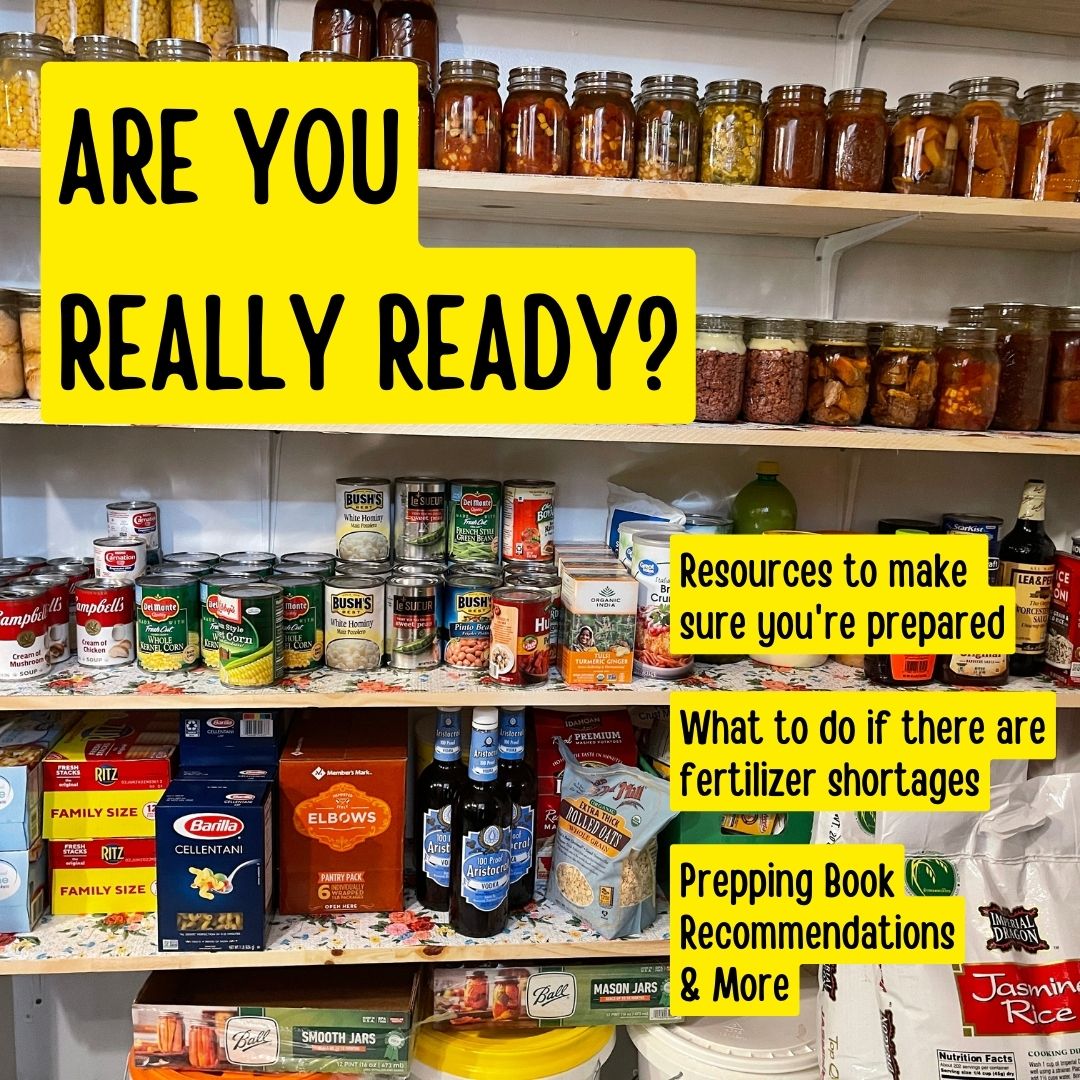
Editor’s note: A retired Master Gunnery Sergeant in the USMC, Phil Molloy is the epitome of resourcefulness and preparedness, and always the first to respond in the event of any emergency or natural disaster. He has been sending out a Hurricane Preparedness beacon for years, and it’d be wise for anyone to bookmark this, use the “Print” button on this page to print a copy. I also encourage you to forward this to all of your friends. Although this was written with an eastern North Carolina audience in mind, this isn’t your average guide to Hurricane Preparedness. This is truly Disaster Planning 101.
By Master Gunnery Sergeant Phil Molloy, USMC (Ret.)
Yep! It’s that time of year already… hurricane season.
Purchase supplies that you need early! Don’t wait for a storm. When a storm threatens, lines will be long and supplies short (or non-existent).
Although the title leads one to believe this is a Hurricane Preparedness Guide, following this guide will actually prepare you for much more than a hurricane. It’s generally good for any event that may affect you and your family physically or economically. Short-term economic collapse, flood, snow storm (just add a heat source), power outage, wind storm, earthquake, or any other short-term incident that could seriously depress your day to day routine and family survival. So, as you read and use this guide, think of other situations you think it’s wise to prepare for and just fill in the blanks yourself.
Remember, this is only a guide. With this, you should customize a plan that best fits whatever situation you think you should prepare for. And if you’re new to the “prepper” community, what I’ve provided here is a very good start.
Always remember that the number one known threat to Eastern North Carolina – especially to the Coastal Plains and the Outer Banks – is a hurricane.
Hurricane preparation is important for the safety and comfort of you and your loved ones both during and after a storm. Many of the items I’ve listed for purchase here were, of course, gleaned from the many lists available to citizens. However, much of what you will see here (recommended purchase items and actions) was developed from trial and error – lots of errors. More was developed from experience in the rescue and recovery efforts of several hurricane disaster areas to include Floyd, Hugo, Andrew, and Katrina.
Post-hurricane isn’t pretty, folks. Fact is – it can get very ugly – sometimes total devastation “like a combat zone,” as it has often been described after a destructive storm.
Forewarned is forearmed
The National Weather Service Hurricane Center has warned that storms will increase in frequency and intensity over the next two decades. Don’t be caught unprepared! The Federal Emergency Management Agency (FEMA) recommends you keep a minimum of a 3-day supply on hand at all times. The Latter Day Saints recommend being prepared to be self-sustaining for one year. I recommend not less than a 15-day supply. Why? Because that’s the far-end average of getting past most situations we historically encounter. Of course that’s the best I can determine with the data available, but you can do your own research and determine what level of preparedness is best for you and your family.
Once again, our own preparedness served my family (and a few unprepared neighbors) quite well after the somewhat mild, but relentless, winds of Hurricane Irene in August 2011. Being on the coast and on the mainland at the southern tip of the Outer Banks, Irene was determined to overstay her welcome. Though there was no significant damage to local structures, trees and limbs took out enough of the power lines to keep us in the dark for over two weeks. I was able to supply power enough for our neighbors to keep their refrigerator and freezer going and I got two other neighbors together to share another generator for the same thing. My home had everything we needed – water, lights, fans, and a small 125v window A/C unit I mounted in the bedroom window for sleeping in the summer’s heat. The entire event only caused me the aggravation of having to refuel the generator every 18 hours. I even had enough fuel for the whole two weeks!
My friends, neighbors — and even some family — once thought I went just a little overboard with preparations. I don’t think I do too much, and I certainly didn’t do it all at once – it has taken years – but they now all appreciate the time I take to write things such as this Hurricane Preparedness annual. They know I’ve used most of what I recommend and that I will always help them make the best purchase decisions. So, in answer to those with the question, “Do you, or have you, really used these?” Yes, I do!
Coastal North Carolina Preparedness
What, exactly, do you need to consider if you live in the Eastern/Coastal Plains of North Carolina?
NOTE: I use a category-4 hurricane as an example because it is the most powerful storm you could possibly hope to survive in place. (We’re relatively protected by location but I wouldn’t stay in the area for more than a very low category-3.) If the warning is for a category 5 storm – EVACUATE! Do not expect to ride out a category-5 hurricane in safety. Emergency services will not be available during the height of the storm and very limited or not at all afterwards. Don’t get the picture? Look up “Hurricane’s Andrew, Katrina, Bertha, and Ike…” Scary, isn’t it?
Let’s start with “after the storm”…
Imagine that a category 4 storm has caused major destruction to your town and your neighborhood. Most of the windows are out of your house and part of the roof is gone – just like most of your neighbors. You’ve survived the storm, but now that it’s passed, the power lines are down, roads are blocked (and often unidentifiable) and all essential services are unavailable – no water, no sewer, no electricity, no gasoline. The bugs and mosquitoes are horrendous, the snakes have come out of hiding, abandoned or lost domestic animals are hunting for food, and the heat and humidity are sweltering. BUT, unlike your neighbors, you were prepared! You have a generator, plenty of water, food, tools and materials to secure your shelter, and lights and electric/battery powered fans to make the hot, humid nights more tolerable. How did you know what to do before the storm and prepare for this day? Read on…
First, P-R-I-O-R-I-T-I-Z-E!
To do this, I suggest you focus your funds on “after” the storm because, after the anxiety of the storm itself, this will be the longest and most trying time. The lists here are not all-inclusive but they’re a good place to start. You can, and should, customize your own list to meet your personal and family needs. Unless you make entirely too much money, or you believe hurricane preparation is worth a large investment now and the bank’s loan department likes you, start small and work your way up. It’s all a matter of prioritizing.
Your focus should be preparation before the storm, survival and safety during the storm and survival, safety, and comfort after the storm.
If you have not been through a serious hurricane, don’t do as many have and be lulled into a false sense of security. Don’t think, “We’ll be okay — just like always,” or, “We don’t get the really bad storms in North Carolina,” or (here’s the worst comment), “I’ve been through one they said was going to be bad but it was nothing!” Hint: No major storm has hit our coast at high tide since Hazel in 1954. Hazel hit NC as a category 4 and was responsible for nearly 1200 deaths all the way into Canada! And don’t forget weather events that are not classified as hurricanes, like the Ash Wednesday Storm that struck the Outer Banks March 7, 1962 with (as Andy Griffith said in 1986) “a violence beyond imagination.” Ocean piers and cottages vanished, or were completely devastated in that storm. And don’t think it doesn’t snow in Eastern NC. It does!
In the early days of March 1980, this region was the target of a blizzard the likes of which had never been seen here …and I survived it just a few hundred yards from where I live today. Snow fall of up to 30 inches were recorded with associated wind gusts in excess of 50 mph snow drifts up to 8 feet! All travel in NC came to a complete halt with hundreds stranded in their cars. Property damage was estimated at $21.8 million and there were 13 storm related deaths – 8 were less than 20 miles from me! Although the number one risk in Eastern NC is hurricanes, don’t rule out the others. A plan for one can be a plan for many.
Though we haven’t been hit with any major storms recently, I suspect we are long overdue for a real hum-dinger. Ask anyone who has “been there – done that” and they will likely tell you the same thing.
It’s always a good idea to look into some basic emergency rescue and first aid training so you can help yourself and your neighbors after a nasty incident like a tornado or hurricane. The Community Emergency Response Team (CERT) course is an excellent place to start and is made for anyone from eight to eighty. Get your organization, neighborhood, scout troop, business, or church group involved. After a devastating event, emergency responders may be hours or days away from reaching you. Being trained as a CERT responder is a great way to save lives, care for the wounded, or protect property until they arrive. Contact your county Office of Emergency Services for more information.
Basic Hurricane Kit
Assemble this now. Put items aside in a special box, or have them identified to pull together to prepare for the storm. Keep heat-sensitive items inside the home and rotate stock as needed throughout season.
- Flashlights and extra batteries
- Clock (wind-up or battery-operated)
- Battery-operated radio – a NOAA Weather Radio is inexpensive and a great addition to your kit
- Battery-operated fan. These are available in most sporting goods departments (K-Mart, Wal-Mart, etc.) Buy a couple – you won’t regret it!
- Toilet paper
- Matches, matches, matches! See camping stores for waterproof matches or seal some in zip-lock bags.
- Scissors
- Plastic garbage bags – at least a box of 30 or 33gal size
- Working fire extinguishers – a 2-1/2lb and a 5lb. Most house fires could have been contained if the resident had used one when the fire started. Remember, a flood is bad; a tree in your roof is bad, losing power is bad, but fire eats everything!
- A clean change of clothes, rain gear, and sturdy work/swamp boots (“Sneads Ferry Sneakers” – as some call them here – work well) – ones you would not mind throwing away. You don’t want to be out wearing your flip-flops after the storm. As cool and comfortable as they might be, they won’t protect your feet and severely damaged areas will be inundated with nails, trash, chemicals, snakes, and other critters.
- Battery-operated lanterns. You should not use candles and kerosene lanterns – especially around pets. They are fire hazards and pets will knock them over. Don’t scrimp on lighting. You may have experienced loss of power for a few, or even several hours in the past but imagine no lights for days or weeks! Battery powered items – especially lights – were at a premium in Florida for several weeks after Hurricane Andrew.
- Map of the area. You may know your area very well but trust me on this one; hurricanes have a way of changing the landscape. And, oh, forget about street signs. There won’t be any.
- List of important phone numbers written on a couple of 3×5 cards – even if they’re in your cell phone.
- Copy of home insurance policy and other important papers. A co-worker of mine has his papers already in large zip-lock bags to keep them dry – a great idea! Keep a good supply of spare batteries! It is highly recommended that you install fresh batteries in all battery-powered equipment every year before the start of the hurricane season. This is a small cost when related to the discomfort of losing battery power when you need it most because the batteries have leaked and destroyed your equipment. This also gives you the opportunity to check the proper operation of your equipment. Rotate your spare battery supply year round by using and replacing regularly.
- Emergency toilet (What goes in must comes out!)
- A 5-gallon bucket with tight lid
- Plastic bags for liners
- Disinfectant or bleach
- Deodorizer
- Extra toilet paper
- Baby needs
- Disposable diapers
- Wipes
- Diaper-rash ointment
- Baby medicines
- Medicine dropper
- Extra formula, baby food
Food supplies
I recommend you have enough nonperishable foods for two weeks (but not less than three days). Put them in a box and leave them alone. [NOTE: Canned and other prepared foods that are salty or dry or high in fat or protein might make for good provisions, but they’ll make you thirsty.] Write the date on all packaged food items with a permanent marker. Mark the date and contents on the end of all canned goods (water/moisture may remove label). Write down a few simple meal recipes and match your supply to the menus. This will make it easier to know if you have the right items to meet your needs. Put a copy of the menu in with the food items as a reminder of your plan.
- Water: 2 quarts (small child) to 1 gallon (large child/adult) per person per day (have a week’s supply); have extra water for mixing powdered drinks and more if you’ll be working in the heat… and you will.
- Ice or dry ice. CAUTION: understand how to handle/use dry ice before you buy any
- Shelf-stable juice and milk
- Canned and powdered milk
- Beverages (powdered or canned, fruit juices, instant coffee, tea)
- Raw vegetables that don’t need refrigeration (will last only a few days)
- Canned vegetables and fruits
- Dried fruits
- Prepared foods (canned soups, beef, spaghetti, tuna, chicken, ham, corned beef hash, packaged pudding, and one of my favorites – SPAM)
- Snacks (crackers, cookies, hard candy, unsalted nuts)
- Snack spreads (peanut butter, cheese spreads, jelly)
- Cereals (if you don’t mind it with rehydrated milk)
- Sugar, salt, pepper, and a couple of your favorite spices
- Bread
- Dry and canned pet food (don’t forget extra litter if you have cats – 10 lbs per cat each week). Pets should have their own bag with a few essentials – don ‘t forget to have a copy of their medical file if you have to evacuate! You will need appropriate documentation of your pet’s vaccinations if you have to board them outside the target area. Also, have a list of motels/hotels that will accept pets should you need to evacuate – there are many of them
NOTE: Do you have sufficient coolers to handle your ice and perishables? Check now!
Kitchen supplies
- Waterless hand sanitizer
- Manual can opener/bottle opener
- Water purification tablets (you can always boil)
- Matches in a plastic bag
- Pocketknife
- Camp stove or other cooking device and plenty of fuel. Use only canned fuel indoors – never charcoal or gas. Buy extra gas or charcoal for your grill to use in well-ventilated space after storm has passed.
- Ice chests or coolers
- Paper plates, napkins, plastic cups, plastic utensils, and plenty of paper towels – better than regular dinnerware for sanitary reasons
- Disposable pans for cooking
- Plastic bags, jugs or containers for water and ice
Hardware
- Hand tools: hammer, nails, axe/hatchet, and shovel for after the storm – determine your own needs.
- Power screwdriver/drill to mount plywood over your windows. If you have a brick home, there are special clips available at hardware stores to use in place of screws and nails.
- Sheets of ½” thick plywood to cover your windows. Pre-cut these to fit your windows and mark them for the window that each fits. Have a sufficient amount of 2” or 2½” all-purpose screws to secure to window frames. Pre-cut plywood does not take up much space in a garage or workshop. All of mine takes about 4’x13″ of floor space against a wall. Hint: drill three or four 1½” holes about one third of the way up the middle of each pre-cut window cover. This gives a tiny bit of light and allows you to see out in relative safety if you’re staying in place during the storm.
- ¼ inch machine screw sockets (for your power drill) and hex head screws
- Plastic sheeting to cover furniture. (See “other supplies” below)
- Rope – comes in handy if you have to move or secure something. I recommend a few 50’ pieces – the cheap stuff is okay. Don’t forget clothesline and some clothespins.
- Sturdy working gloves and a few dust/painters masks (get the N-95 masks – they have other uses).
- Duct tape to waterproof or secure items – masking tape isn’t strong enough
- Tarps – shop around for these. You don’t need the extra thick ones. The cheap ones will work just as well for quick repairs or covering items you need to protect. A couple of 8×10’s and a 10×20’ are good to start with. Build your supply each year (I keep 10 6×8’, 6 8×10’ and 4 10×20’).
- Nails. There are many kinds, so look over your home now and determine what you will need. A nail that’s too small, the wrong shape, or hammered in wrong will fail and will give the storm the breach it needs to get into your home. Think about possible needs for these after the storm too. I keep at least 1 box each of 1½” roofing, 10d, and 16d nails. I also have several ‘furring strips’ – 3/8”x1-1/4”x6’ strips of wood to nail over tarps so the nails don’t pull through in the wind.
First-Aid Kit
Drugstores will be mobbed just before a major storm and closed for days after. Keep a two-week supply of prescription drugs. Check with your doctor and pharmacist ahead of time to determine what you have to do to get these! Your first-aid kit should include:
Medical supplies
- First-aid handbook (take it out and read it now folks – NOT when you need it).
- Insect repellent sprays – pump bottles are best – have plenty on-hand because the insect population will be horrendous after the storm and if your home is damaged or you have to be outside, you will need lots of this. Insect repellent was in short supply after Hurricane Floyd. Follow the label instructions. Many repellents require application about every 3-4 hours. Use it correctly.
- Citronella candles – some people believe these work but I can’t find any data to support it
- Insect bite lotion – the pain of a bite is the last thing you need to worry about
- Petroleum jelly – to relieve itching and a multitude of other uses
- Ointments for burns, cuts
- Antiseptic solution/iodine
- Sunscreen
- Extra over-the-counter medicine (for colds, allergies, cough)
- Aspirin, acetaminophen, antacid tablets (you’ll need these)
- Children’s medicines
- Diarrhea control – Pepto Bismol® is always good to have
- Feminine hygiene items
- A bottle each of rubbing alcohol and hydrogen peroxide
- Disinfectant – keep a couple of cans on-hand. Lysol® works well as does the Clorox® “Spray Anywhere” (good stuff)
- Bar soap (in plastic bags)
- Moist Towelettes or Baby Wipes
- Standard supply of bandages, band aids, medical tape, etc.
Other supplies
- Plastic sheeting – painters drop cloths work great. You can buy several large ones for a few dollars in the paint section at any hardware store. They come in small packages (get the 4-6mil thickness).
- Latex gloves or, better yet – dishwashing gloves.
- Generators – IMPORTANT: You can go all-out and buy a generator but know what you’re getting into. Do you know how to use it? Will it be connected directly to your house to run everything or will you plug cords into it for your refrigerator, freezer, a couple of fans, and coffeemaker? Know how long it will run on a tank of fuel. It’s my experience that most people with generators purchase only one or two gas containers which will last less than two days. If you have no power for a week, you will quickly run out of fuel. Decide how long each day you will need to run your generator and plan your fuel accordingly. I rotate gas into my car, truck, and lawnmower throughout the season so it’s always fresh. Know how to service your generator and how often it needs to run during the year.
- If you keep gas in your equipment or in containers for more than a couple months at a time, get a bottle or two of FUEL SAVER or FUEL FRESH – available in most hardware stores and department stores under various brand names like Sta-bil® or Seafoam®. This will keep the gasoline from becoming useless or turning into varnish inside the engine’s fuel system and damaging your equipment.
Purchase your supplies early because, after a destructive storm, NOTHING WILL BE AVAILABLE FOR DAYS OR WEEKS!
Have a plan and stick to it. Write it down in a notebook while the pressure is off. Keep it in a place you won’t forget.
‘Stay at Home’ Checklist
- Remove all loose debris, lawn furniture, etc
- Empty and/or secure trash containers – keep one in the house, garage, or on the deck and fill with water. If the storm aftermath is bad, you will quickly discover why I recommended this.
- Secure all windows (board or shutter). DO NOT TAPE YOUR WINDOWS! Taping serves no functional purpose whatsoever and is hard to remove.
- Prepare for loss or disruption of essential utilities – water, sewer, trash pickup, electricity, etc.
- Service your vehicle and ensure it has a full tank of gas
- Turn refrigerator to maximum cold and do not open unless necessary (fill a cooler with ice for items you expect to use frequently)
- Fill unbreakable containers with water and freeze – they can be left in place or later moved to the refrigerator or cooler. I use milk and juice containers, plastic soda bottles, and zip-lock bags for this.
- Check your disaster supply stock and ensure you have at least a 3-day supply
‘Leave the Area’ Checklist (Bug-Out 101)
- Remove all loose debris, lawn furniture, etc
- Empty and secure trash containers
- Secure all windows (board or shutter – DO NOT TAPE)
- Service your vehicle and ensure it has a full tank of gas
- Shut off water/electricity/gas
- Lock house – board-up remaining doors – and tell a neighbor if necessary
- If you are going to a shelter or commercial lodging, plan for the care of your pets. Check for a veterinary clinic near your destination or check with area motels – most allow a couple of domestic pets. Your own veterinarian can help and will also give you the appropriate documentation – shot record, etc – for the other clinic (DO NOT LEAVE PETS BEHIND – if it’s not safe for you, it is not safe for your pets!)
- Leave early – in daylight if possible. Have a ‘decision timeline’ – Example: “if the storm is [this strong] and it’s [this close to us], we will leave”. Have a departure plan and stick to it. Once the decision is made, take action. Don’t “second guess” any plan you made when no threat existed – just follow it!
- Ensure someone knows your travel route and destination – preferably a family member who lives somewhere that is not threatened by the incident
- Take small valuables and important papers – have a checklist and/or know where they are. Don’t try to find them when you’re getting ready to leave …prepare, prepare, prepare
- If going to a shelter, have the following items: water, food, clothing, bedding, personal medications, and special items (don’t forget that battery powered fan I told you about!). Pets are not normally allowed in shelters. However, some counties do provide a special shelter for domestic pet owners or a list of pet-friendly hotels. Check with your local Office of Emergency Management – DO IT NOW
- Pet Supplies – be sure to have everything Fido, Fluffy, and Polly may need for a storm – especially if you have to evacuate – bedding, pet carrier/cage (at a shelter, they will be in this most of the time so be sure they have a little extra room), water, food, medications, and your pet’s record of required shots and vaccinations – rabies, distemper, etc – that your veterinarian should be happy to supply. I don’t think many shelters will take pets without a shot record but you can ask that question ahead of time when you call your local Office of Emergency Management.
- Will you be pulling a trailer? This could be a good idea if you have a lot to carry and will be attempting to return immediately after the storm. If it’s a utility trailer, don’t forget to tie down the tarp tightly. If you happen to be one of the lucky few who has a camper, good for you. I won’t tell you how to stock it to live since you already know that. However, you’ll be carrying lots more when you evacuate so be careful to properly balance and secure your load. Carry a small air compressor for your tires, have a tire repair kit with plugs, and have at least one bottle of tire sealer (you know, that ‘green goop’) for each tire. The roads may be strewn with nail impregnated trash and the “green goop” will cut down on tire repairs on the road. If you really want to be ready, seal the tires now …but be prepared to listen to the angry words from the guy who has to mount your new tires next time because they say the goop makes a mess!
- If you are leaving with more than one vehicle (you and your spouse/other family member are each driving one), have a couple of small “walkie talkies” which are available at most department store electronics or sporting goods sections. Traffic on the evacuation route will be terrible and you will be glad you can talk to one another. No, you will not be able to talk on your cell phone. During major evacuations, cell signal availability will be at a premium so DON’T COUNT ON IT! For you older folks – Baby Boomers like me – learn to text. Yes, I said it – learn. When cell service is sketchy and your voice calls keep getting dropped, texting will be much more reliable. If you’re going to text old Uncle Lou, be sure he knows how too!
If you can completely prepare your home and family for a hurricane in less than a day utilizing most of the items and preparation techniques I’ve mentioned, congratulations! You paid attention, built your supplies, planned well, and you are prepared!
Stay Safe!
Phil Molloy is an Emergency Medical Technician, Floodwater Rescue Technician, Firefighter, Heavy Rescue Technician, SARTECH, Police Officer, Tactical Medic, NC Certified Emergency Manager, retired U.S. Marine, and Captain on the Onslow County Special Incident Response Team. He has been involved with numerous disaster rescue and recovery operations in North and South Carolina, Georgia, Florida, Virginia, Texas, California, and Wyoming – as both a civilian and in his duties as a Marine. He has been involved in Emergency Services since 1975. He currently works with Future Operations at Marine Corps Installations East-Marine Corps Base, Camp Lejeune, NC.








